by Lisa Berman, Education Center Director
Picture this: a sixth grader, participating in an education program at Mayyim Hayyim, responds to the question “who do you think might accompany someone when they are at or in the mikveh?” He answers: “No one. Well, maybe God.”
Both of these 2 very brief statements are fascinating to me as the Director of the Paula Brody and Family Education Center. They actually represent a typical learning experience at Mayyim Hayyim. Here’s how.
We lead more than 100 educational programs every year at Mayyim Hayyim (plus a few in far-flung places such as North Carolina and California). This reflects the fact that one of our founding principles was chinuch, education. It is just as important to us to teach about mikveh as it is for us to have someone use the mikveh.
Of those 100+ programs, about half are for groups of adults – Intro to Judaism classes, Sisterhoods, Men’s Clubs, rabbinical students, Rosh Hodesh groups, college classes, etc. The other half of the programs are for youth – 4th through 12th graders from congregational, independent and day schools — even churches! People who come to learn at Mayyim Hayyim don’t know very much about the ritual of mikveh – that’s the norm. Consequently, we need to start by conveying the same basic information, whether it is to groups of 10 year olds or, for example, to retirees: what a mikveh is, where it comes from in our texts and tradition, what the ritual entails, and the different reasons why people use it.
However, to generalize, kids and grown ups walk in with their heads in different places. Grown ups tend to have preconceived notions about mikveh, not always positive. Maybe even some baggage about it. Kids on the other hand come to us tabula rasa – blank slates. To them, our program is just a field trip to learn something they just haven’t been taught about yet. They come, they learn, they dangle their hands in the water, and, much to my amazement, they leave 90 short minutes later with a very solid understanding about this ritual, including the belief that mikveh is totally normative – something that would be cool for kids to do before they become bar or bat mitzvah, not to mention meaningful for many other moments of transition. Our job as educators here is just to fill them up with learning and experiences, and let them soak it in and process it. For adult learners, on the other hand, our job is often to change their minds about what mikveh can be. It’s not a hard job, mind you, especially when we have this beautiful facility to use as a teaching tool.
So, back to our 6th grader. He learned that, at Mayyim Hayyim, having someone to witness your immersion is usually optional, and is correct when he states that there might be “no one” else present. But how beautiful it is that he processed the nature of this ritual himself to conclude that, well, maybe God would be there with the person. We don’t actually talk much about God in our educational programs. He just figured it out. (I think he’s right.)
Lisa Berman, Education Center Director, has been involved with Mayyim Hayyim since its opening in May 2004. Lisa trained as a Volunteer Mikveh Guide and then served as the liaison to area congregational religious schools and adult study groups. Since 2006, Lisa has directed the Paula Brody & Family Education Center, where she develops curricula for all ages and interest levels; she also organizes and oversees more than 90 programs annually. A convert, Lisa is especially sensitive to the challenges experienced by interfaith families, particularly around milestone events.


